 |
Open CASCADE Technology
7.2.0
|
Table of Contents
Introduction
This document presents guidelines for building third-party products used by Open CASCADE Technology (OCCT) and samples on Windows platform. It is assumed that you are already familiar with MS Visual Studio / Visual C++.
You need to use the same version of MS Visual Studio for building all third-party products and OCCT itself, in order to receive a consistent set of run-time binaries.
The links for downloading the third-party products are available on the web site of OPEN CASCADE SAS at http://www.opencascade.com/content/3rd-party-components.
There are two types of third-party products used by OCCT:
- Mandatory products:
- Tcl/Tk 8.5 – 8.6;
- FreeType 2.4.10 – 2.5.3.
- Optional products:
- TBB 3.x – 4.x;
- gl2ps 1.3.5 – 1.3.8;
- FreeImage 3.14.1 – 3.16.0;
- VTK 6.1.0.
It is recommended to create a separate new folder on your workstation, where you will unpack the downloaded archives of the third-party products, and where you will build these products (for example, c:\occ3rdparty).
Further in this document, this folder is referred to as 3rdparty.
Building Mandatory Third-party Products
Tcl/Tk
Tcl/Tk is required for DRAW test harness.
Installation from sources: Tcl
Download the necessary archive from http://www.tcl.tk/software/tcltk/download.html and unpack it.
- In the win sub-directory, edit file buildall.vc.bat:
Edit the line "call ... vcvars32.bat" to have correct path to the version of Visual Studio to be used for building, for instance:
call "%VS80COMNTOOLS%\vsvars32.bat"
If you are building 64-bit version, set environment accordingly, e.g.:
call "%VS80COMNTOOLS%\..\..\VC\vcvarsall.bat" amd64
- Define variable INSTALLDIR pointing to directory where Tcl/Tk will be installed, e.g.:
set INSTALLDIR=D:\OCCT\3rdparty\tcltk-86-32
- Add option install to the first command line calling nmake:
nmake -nologo -f makefile.vc release htmlhelp install %1
- Remove second call to nmake (building statically linked executable)
Edit file rules.vc replacing line
SUFX = tsgx
by
SUFX = sgx
This is to avoid extra prefix 't' in the library name, which is not recognized by default by OCCT build tools.
- By default, Tcl uses dynamic version of run-time library (MSVCRT), which must be installed on the system where Tcl will be used. You may wish to link Tcl library with static version of run-time to avoid this dependency. For that:
- Edit file makefile.vc replacing strings "crt = -MD" by "crt = -MT"
- Edit source file tclMain.c (located in folder generic) commenting out forward declaration of function isatty().
In the command prompt, run buildall.vc.bat
You might need to run this script twice to have tclsh executable installed; check subfolder bin of specified installation path to verify this.
- For convenience of use, we recommend making a copy of tclsh executable created in subfolder bin of INSTALLDIR and named with Tcl version number suffix, as tclsh.exe (with no suffix)
> cd D:\OCCT\3rdparty\tcltk-86-32\bin > cp tclsh86.exe tclsh.exe
Installation from sources: Tk
Download the necessary archive from http://www.tcl.tk/software/tcltk/download.html and unpack it.
Apply the same steps as described for building Tcl above, with the same INSTALLDIR. Note that Tk produces its own executable, called wish.
You might need to edit default value of TCLDIR variable defined in buildall.vc.bat (should be not necessary if you unpack both Tcl and Tk sources in the same folder).
FreeType
FreeType is required for text display in a 3D viewer. You can download its sources from http://sourceforge.net/projects/freetype/files/
The building procedure
- Unpack the downloaded archive of FreeType product into the 3rdparty folder. As a result, you will get a folder named, for example, 3rdparty\freetype-2.4.10. Further in this document, this folder is referred to as freetype.
- Open the solution file freetype\builds\win32\vc20xx\freetype.sln in Visual Studio. Here vc20xx stands for your version of Visual Studio.
- Select the configuration to build: either Debug or Release.
Build the freetype project.
As a result, you will get a freetype import library (.lib) in the freetype\obj\win32\vc20xx folder.
If you build FreeType for a 64 bit platform, select in the main menu Build - Configuration Manager and add x64 platform to the solution configuration by copying the settings from Win32 platform:
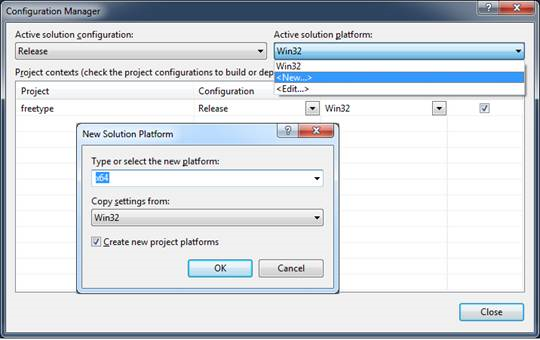
Update the value of the Output File for x64 configuration:
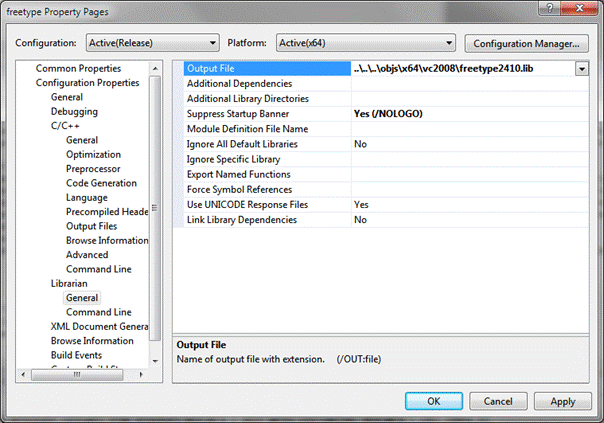
Build the freetype project.
As a result, you will obtain a 64 bit import library (.lib) file in the freetype\x64\vc20xx folder.
To build FreeType as a dynamic library (.dll) follow steps 6, 7 and 8 of this procedure.
- Open menu Project-> Properties-> Configuration Properties-> General and change option Configuration Type to Dynamic Library (.dll).
Edit file freetype\include\freetype\config\ftoption.h:
in line 255, uncomment the definition of macro FT_EXPORT and change it as follows:
#define FT_EXPORT(x) __declspec(dllexport) x
Build the freetype project.
As a result, you will obtain the files of the import library (.lib) and the dynamic library (.dll) in folders freetype \objs\release or \objs\debug .
If you build for a 64 bit platform, follow step 5 of the procedure.
To facilitate the use of FreeType libraries in OCCT with minimal adjustment of build procedures, it is recommended to copy the include files and libraries of FreeType into a separate folder, named according to the pattern: freetype-compiler-bitness-building mode, where:
- compiler is vc8 or vc9 or vc10 or vc11;
- bitness is 32 or 64;
- building mode is opt (for Release) or deb (for Debug).
The include subfolder should be copied as is, while libraries should be renamed to freetype.lib and freetype.dll (suffixes removed) and placed to subdirectories lib *and *bin, respectively. If the Debug configuration is built, the Debug libraries should be put into subdirectories libd and bind.
Building Optional Third-party Products
TBB
This third-party product is installed with binaries from the archive that can be downloaded from http://threadingbuildingblocks.org/. Go to the Download page, find the release version you need (e.g. tbb30_018oss) and pick the archive for Windows platform.
Unpack the downloaded archive of TBB product into the 3rdparty folder.
Further in this document, this folder is referred to as tbb.
gl2ps
This third-party product should be built as a dynamically loadable library (dll file). You can download its sources from http://geuz.org/gl2ps/src/.
The building procedure
Unpack the downloaded archive of gl2ps product (e.g. gl2ps-1.3.5.tgz) into the 3rdparty folder.
As a result, you will get a folder named, for example, 3rdparty\gl2ps-1.3.5-source.
Rename it into gl2ps-platform-compiler-building mode, where
- platform – win32 or win64;
- compiler – vc8, vc9 or vc10;
- building mode – opt (for release) or deb (for debug).
For example, gl2ps-win64-vc10-deb
Further in this document, this folder is referred to as gl2ps.
- Download (from http://www.cmake.org/cmake/resources/software.html) and install the CMake build system.
Edit the file gl2ps\CMakeLists.txt.
After line 113 in CMakeLists.txt:
set_target_properties(shared PROPERTIES COMPILE_FLAGS \"-DGL2PSDLL -DGL2PSDLL_EXPORTS\")
add the following line:
add_definitions(-D_USE_MATH_DEFINES)
Attention: If Cygwin was installed on your computer, make sure that there is no path to it in the PATH variable to avoid possible conflicts during the configuration.
Launch CMake (cmake-gui.exe) using the Program menu.
In CMake:
- Define where the source code is. This path must point to gl2ps folder.
- Define where to build the binaries. This path must point to the folder where generated gl2ps project binaries will be placed (for example, gl2ps\bin). Further in this document, this folder is referred to as gl2ps_bin.
Press Configure button.
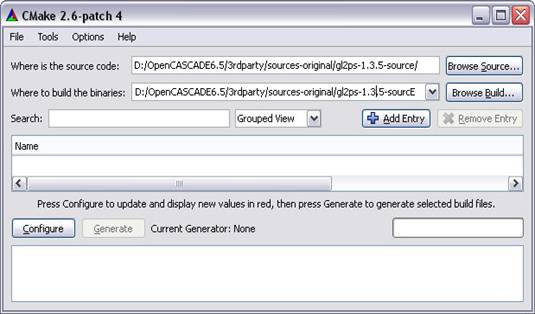
Select the generator (the compiler and the target platform – 32 or 64 bit) in the pop-up window.
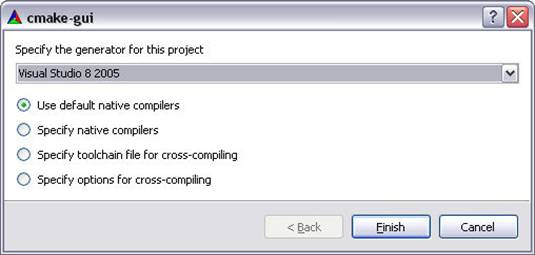
Press Finish button to return to the main CMake window. Expand the ENABLE group and uncheck ENABLE_PNG and ENABLE_ZLIB check boxes.
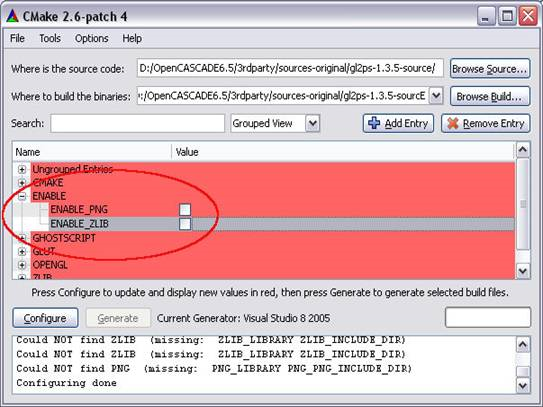
Expand the CMAKE group and define CMAKE_INSTALL_PREFIX which is the path where you want to install the build results, for example, c:\occ3rdparty\gl2ps-1.3.5.
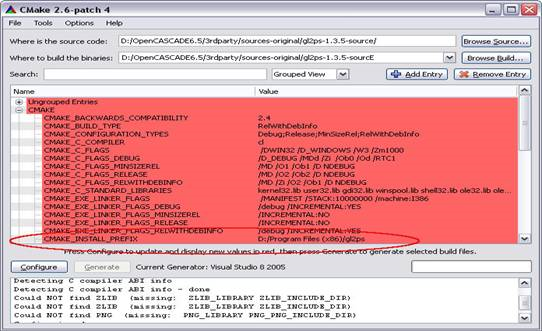
- Press Configure button again, then press Generate button to generate Visual Studio projects. After completion, close CMake application.
- Open the solution file gl2ps_bin\gl2ps.sln in Visual Studio.
- Select a configuration to build
- Choose Release to build Release binaries.
- Choose Debug to build Debug binaries.
- Select a platform to build.
- Choose Win32 to build for a 32 bit platform.
- Choose x64 to build for a 64 bit platform.
- Build the solution.
- Build the INSTALL project.
- Select a configuration to build
As a result, you should have the installed gl2ps product in the CMAKE_INSTALL_PREFIX path.
FreeImage
This third-party product should be built as a dynamically loadable library (.dll file). You can download its sources from http://sourceforge.net/projects/freeimage/files/Source%20Distribution/
The building procedure:
Unpack the downloaded archive of FreeImage product into 3rdparty folder.
As a result, you should have a folder named 3rdparty\FreeImage.
Rename it according to the rule: freeimage-platform-compiler-building mode, where
- platform is win32 or win64;
- compiler is vc8 or vc9 or vc10 or vc11;
- building mode is opt (for release) or deb (for debug)
Further in this document, this folder is referred to as freeimage.
Open the solution file freeimage\FreeImage..sln* in your Visual Studio.
If you use a Visual Studio version higher than VC++ 2008, apply conversion of the workspace. Such conversion should be suggested automatically by Visual Studio.
Select a configuration to build.
- Choose Release if you are building Release binaries.
- Choose Debug if you are building Debug binaries.
Note:
If you want to build a debug version of FreeImage binaries then you need to rename the following files in FreeImage and FreeimagePlus projects:
Project -> Properties -> Configuration Properties -> Linker -> General -> Output File
FreeImage*d*.dll to FreeImage.dll FreeImagePlus*d*.dll to FreeImagePlus.dll
Project -> Properties -> Configuration Properties -> Linker -> Debugging-> Generate Program Database File
FreeImage*d*.pdb to FreeImage.pdb FreeImagePlus*d*.pdb to FreeImagePlus.pdb
Project -> Properties -> Configuration Properties -> Linker -> Advanced-Import Library
FreeImage*d*.lib to FreeImage.lib FreeImagePlus*d*.lib to FreeImagePlus.lib
Project -> Properties -> Configuration Properties -> Build Events -> Post -> Build Event -> Command Line
FreeImage*d*.dll to FreeImage.dll FreeImage*d*.lib to FreeImage.lib FreeImagePlus*d*.dll to FreeImagePlus.dll FreeImagePlus*d*.lib to FreeImagePlus.lib
Additionally, rename in project FreeImagePlus
Project -> Properties -> Configuration Properties -> Linker -> Input -> Additional Dependencies
from FreeImage*d*.lib to FreeImage.lib
- Select a platform to build.
- Choose Win32 if you are building for a 32 bit platform.
- Choose x64 if you are building for a 64 bit platform.
Start the building process.
As a result, you should have the library files of FreeImage product in freeimage\Dist folder (FreeImage.dll and FreeImage.lib) and in freeimage\Wrapper\FreeImagePlus\dist folder (FreeImagePlus.dll and FreeImagePlus.lib).
VTK
VTK is an open-source, freely available software system for 3D computer graphics, image processing and visualization. VTK Integration Services component provides adaptation functionality for visualization of OCCT topological shapes by means of VTK library.
The building procedure:
Download the necessary archive from http://www.vtk.org/VTK/resources/software.html and unpack it into 3rdparty folder.
As a result, you will get a folder named, for example, 3rdparty\VTK-6.1.0.
Further in this document, this folder is referred to as VTK.
- Use CMake to generate VS projects for building the library:
- Start CMake-GUI and select VTK folder as source path, and the folder of your choice for VS project and intermediate build data.
- Click Configure.
- Select the VS version to be used from the ones you have installed (we recommend using VS 2010) and the architecture (32 or 64-bit).
- Generate VS projects with default CMake options. The open solution VTK.sln will be generated in the build folder.
- Build project VTK in Release mode.
Generated on Wed Aug 30 2017 17:04:22 for Open CASCADE Technology by
 1.8.13
1.8.13